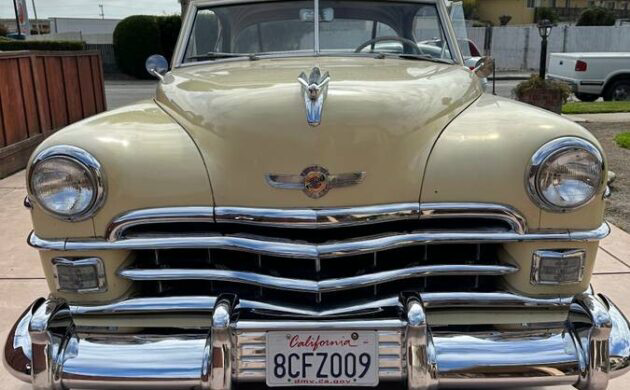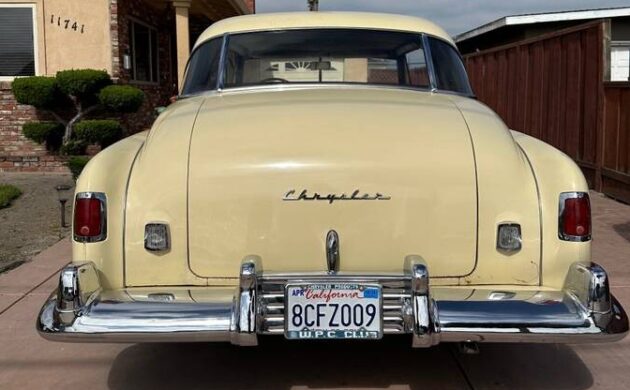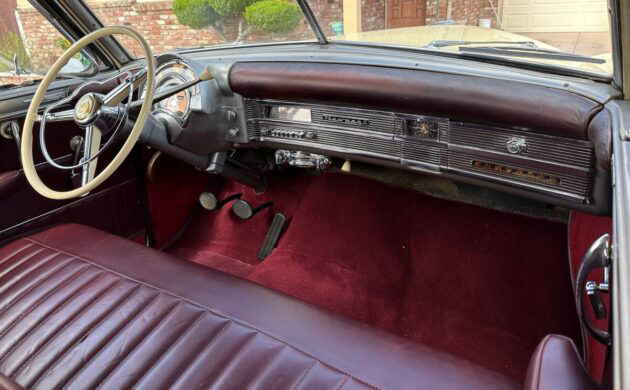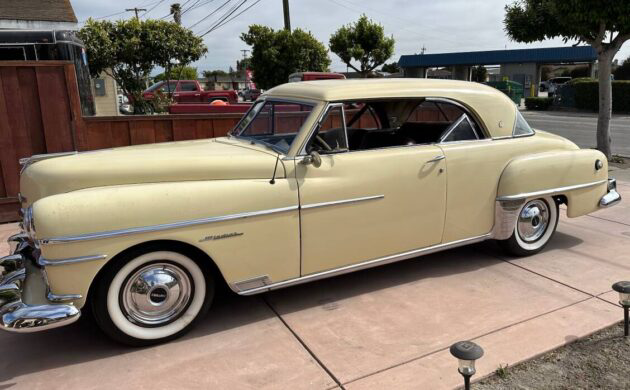THIS is a Chrysler! I have opined before about the events that have reduced this iconic brand, and corporate namesake, to a minivan and an eighteen-year-old four-door sedan several times before. Yes, it’s a bit of a rant, but it’s still frustrating to have lived through the Chrysler brand’s slow descent knowing what they built and sold at one time. This 1950 Chrysler Windsor carries a “Newport” designation owing to its pillarless hardtop design and it does present a magnificent profile. Looking like new, and claiming Castroville, California as its home, this wonderful Windsor is available, here on craigslist for $15,000.
Chrysler’s ’50 line-up was divided into two categories – the large cars such as the Windsor and the Royal station wagon, and the larger cars including the New Yorker, Saratoga, and the Town & Country. Windsor models included, besides this Newport hardtop, a convertible, a two-door club coupe, a four-door sedan, and a stretched limo model with reverse-opening rear doors. The Newport two-door hardtop was copied 9,925 times in ’50 while Chrysler, in general, came in tenth place in the domestic production race with an output of about 180K units. As a comparison, according to Stellantis, the Chrysler brand moved about 112K vehicles in 2022, with the Pacifica accounting for most of the metal movement – I was surprised, I expected it to be lower.
This listing for this Windsor is light with a statement about “real nice chrome all around” being the sole exterior descriptor. And yes, it’s true, the chrome and stainless trim are excellent. So is the cream-hued finish – there is no sign of dullness or fade and the body panels show as being properly aligned. Rust? Nope! One of this Chrysler’s best features is its three-pane rear window – what a styling touch!
The burgundy interior is stated as being new and it looks it! Chrysler’s marketing material from 1950 mentions the availability of leather upholstery and that may be what was used to redo this Windsor – if so, it had to cost a king’s ransom. Of course, it could be vinyl too, but whatever the case, it appears to have been expertly facilitated. One of the interior’s most stunning features is the fluted stainless steel dash trim, it’s a work of art!
Power is provided by a 116 HP, 250.6 CI, in-line, flathead six-cylinder engine attached to a Presto-Matic fluid drive, semi-automatic transmission. It’s technically considered a four-speed (two-speeds with overdrive available for either speed) and utilizes a clutch pedal for certain maneuvers. The electrical system has been converted to 12 volts but no mention is made as to how this car runs and drives.
Yes, this one’s a beauty and it seems like a lot of car for the asking price. Interest in cars of this era may have waned but if you appreciate yesterday’s automotive excellence, this is one to consider, wouldn’t you agree?








Pretty clear, Jim and I are cut out of the same sheet of gasket material. I too remember the stately Chrysler products of the 50s, and how they changed over the course of my years. Not sure why that was. Chrysler didn’t seem to have the stability of GM or Ford, and was swept up in whatever was current for the day, or more accurately, what way every new president took them . Full classics, from the 30s, Chrysler was top of the line. Even post war, still, look at it,,,a mighty impressive car. Seems to me, late 50s, 60s was the uncertainty of Chrysler, obviously trying whatever would work, usually with poor results.
What’s that box on the side of the motor? I had to look that up, it’s a fresh air heater, that I think was an add-on option, before it was moved under the dash and standardized.These were superior cars, and today, that clutch/ automatic setup will only confuse inept people all the more, and a clear deterrent for a sales. As remarkable a car as it is,,,to us, it will be useless in years to come, unless some sort of modern swap. That’s the way it is.
“Useless in years to come” Please explain? Unless gasoline is not available there should be no reason the car can’t be used for decades to come. Consider that all the customers of new gasoline V-8 trucks today will expect to have fuel for their $40,000 and up new truck they just purchased for the next 20-30 years.
Top of the line behind Packard, Peerless, Pierce Arrow in the 30’s.
As stated, a lot of car for the money. Before I said no rust I’d have to take a good look below the trunk, though. Looks a little muddy . . .
I have driven this fluid/matic before and it works fabulously. Leaves with the clutch and becomes automatic thereafter. Surprisingly peppy for such an imposing car. Chrysler definitely had the torque application worked out. Be differrent!
I had a 1950 DeSoto with fluid drive, my first car, it could be shifted as a 3 spd on the tree or left in 3rd and driven like an automatic. That’s how I lost it, my Dad drove it to work one night using the fluid drive putting it in 3rd(high) and not using the clutch. He pulled out onto the highway with a semi coming towards him at least a 1/4 mile away and due to the fluid drive being so slow using high gear only he almost got rear ended by that truck. The next morning he told me to ride the school bus, that afternoon when I came home there was a 1953 Chevy in the driveway. When I asked who it belonged to Dad said it was mine. It took several months to get him to tell what happened, I told him if he drove it like a manual that wouldn’t have happened. I always drove it like a manual unless I had a girl next to me where I could put my arm around her and drive real slow. Lol
Same driving dynamic with my 49 Dodge fluid drive, which I kept in “automatic” as much as possible due to never owning a standard before. When accelerating from a stop it was slow as molasses, and I always worried about drivers behind me not anticipating that or when turning onto another street. The Presto Matic was an option on Mopars and, while never driving one, it seemed much more confusing to me reading about it.
And what about that rust on the gearshift selector? Seems like an unusual area for rusti to form. Makes me nervous about where else that is not in clear view….
I’m sure liking this. On the face of it seems like a fair deal. Stunning interior and beautiful details in my eyes. I had a 1950 DeSoto with the Fluid Drive transmission. Works well. Only detraction is that it starts off essentially in second gear and at about 15 mph you have to lift your foot off the accelerator to get the transmission to shift to high. So a bit sluggish but it works as designed. No clutch needed unless you need to restart or shift into reverse. I’m happy enough with my 1952 Plymouth two door sedan with three on the tree. But this Chrysler is much more upscale and classy. GLWTS.
I learned to drive in a fluid drive 48 dodge. My dad took my one year older brother and me to the long driveway leading to the farm and taught us how to use a clutch. I was 8 years old, that’s the way it was done in those days, if an emergency came up someone had to know how to drive, legal or not. I soon learned how to operate tractors, crawlers and all sorts of equipment. Fluid drive was actually a wet clutch setup soon overcome by better automatic transmissions. This old relic would best be served as a museum piece because like it has been said younger people have no idea how to operate them. I like the two door hardtop versions used by many car makers in the early 50’s and this Chrysler fits the bill.
God Bless America
My father had one of these for about 12 years. Bought it used in 1953, I think. As a kid I was mystified by the fluid drive transmission. The original seats in our car were blue leather around the edges but the center sections, where this car’s seats have pleats, were a corduroy-like fabric in a grayish tan. No pleating as I recall. It was a tank, and I mean that in a good way.
That thing is gorgeous! True Chrysler quality everywhere, just slow as molasses with the flat-head six and fluid drive.
My Mom had a ’50 four door
sedan when I was young. It
had that anniversary blue paint job with a dark blue
interior. To a small boy of 6
or 7, that thing was huge!
The seats were so pillowy I
thought they might swallow
me whole! It was also the
first car Mom bought with a
working radio with not one,
but two speakers. We thought we were hot stuff
riding in a fine car like that in
1960. Can’t recall if it was a
true 3 speed or Prestomatic,
but it was one fine car to be
sure. We were hit broadside
by a 2 year old Ford which was totalled. Not much damage to our car though.
What a tank it was too!
Indeed, the Chrysler name has been taken more than a $20 lady of the evening, not much heritage left. This is a beautiful car, and the price is more than reasonable, compared to most. I like originality, but I’m not a total purist, I would put a later V8 in it, with a compatible transmission, and drive it. That’s what will happen anyway, after us old timers are gone, no new gen’s are gonna putt around in flathead 6
Hellcat yes!
Nice car! Back in the day, a high school buddy had a 1948 Windsor club coupe with the 4 speed semi-auto (I don’t believe it was called a Prestomatic that year). I had a 1949 Dodge Coronet sedan with the Fluid drive 3 speed. Comparing transmissions, I preferred the 4 speed using only the high range (3rd & 4th gears). Low range 1st gear was for pulling stumps. Low range 2nd was too close to High range 3rd gear. My Dodge’s fluid drive could be driven like a normal 3 speed or started in either 2nd or 3rd. As Bob P said, the fluid drive 3rd gear starts were slow. I would say lethargic. I suspect that my buddy’s Chrysler 4 speed was marginally faster than the Dodge, probably due to more horses.
I’m looking at the CL ad: if this is a “mid-size” car, pray tell what is a full-size car? As a 9-10 year-old kid, I had many experiences in these Chrysler products. I remember pulling away from stoplights at about 11 rpm ; ) and I especially remember those beautiful window-cranks with the spring-loaded fold-flat handles – the epitome of high-class!
The iconic Chrysler quality, though, was not unique to the Chrysler brand; even the lowly Plymouths were beautiful in fit, finish, and detail. I could still sense that quality in my aunt’s ’55 Dodge V8 hardtop. But advanced as Exxner’s lines were, something went south with production standards beginning in 1957.
But, my brother-in-law’s 1968 Chrysler station wagon showed a return to the old standards: it was built like a brick outhouse. Great car – and elegantly designed also.
I’ve owned a number of post-1970 Chrysler products and they were all really good – especially my ’79 LeBaron station wagon, my ’85 Fury III, and my ’99 Dakota P/U. The doors on that truck closed like proper Mercedes Benz doors. Fit and finish were superb. Never a rattle in it! And it’s venerable 318 pulled car trailers all over the country without complaint.
But alas, my heart still belongs in that1930’s-50’s world of elegant faux wood dashboards and silent flat-head engines.
Alotta car for 15,000, all of that chrome is worth more than that. Dare to be different, you won’t see yourself coming the other way. I’m not to familiar with the Preso-Matic, I guess Chryco had a few versions of the Fluid-Drive. I read somewhere city cab drivers loved the DeSotos equipped that way, thjey could just leave in 2nd and not bother with the clutch too often.
“Useless in years to come”? How about manual chokes? Clutch pedals? Manual throttles – if you go back far enough? How many drivers under 50 know the need to check the oil with every tank of gasoline? I know of these youngsters who can’t understand why their engines quit; they don’t even know how to find a dipstick, let alone read one.
For some reason I have a thirst for Chrysler Straight Eights. I can’t help but wonder if that could fit in this.
How about finding the shift pattern in the “tree”. Dealing with non-synchronized low (1st) gear? Locating the hi-beam switch on the floor, and on pre-war cars: the starter pedal! Or knowing how to start a postwar Studebaker, or a mid-50’s Buick, for that matter. How about use of “hand signals” for turns? How do you engage an American overdrive? How can you use that overdrive as a semi-automatic transmission – at least for city driving?
My otherwise-brilliant granddaughter was totally perplexed when I asked her to roll the window down on my MGB. She couldn’t find the button.
And even in my generation (old f*rt), how many of us know how to drive Model T Fords? How many of us can effectively use the timing lever on most cars before 1933? How many can use a “starting handle” as my 1959 Morris Minor handbook called it.
I would hope that most modern old car collectors at least know that there is a lot they don’t know.
Amen Allen..”How do you start this thing???”..
I recently purchased a 1948 Chrysler New Yorker Business coupe here thru BF and ebay. And although it said it was running and driving,, along with the fluid drive and prestomatic, it wasn’t. Carb and fuel pump both need rebuilding and none of the electrical was connected to carb for semi automatic to work as designed. Its still a great car and love it but it’s costing another grand to rebuild carb and pump. Who knows what’s involved with electrical to carb afterwards. Buyers beware!
I wonder why it has a ca license plate beginning with an ‘8’… That implies that it was ‘re-licensed’ recently. And, for what reason? I’d be much more impressed if it had a proper and authentic black and yellow plate. A proper black plate with documentation would indicate a long life in ca. (Not one of those new, bogus ca black plates)
These early semi automatics, fluid drives or prestomatics can be a problem if previous owners have disconnected them. Figuring out how to reconfigure both proper carb linkage and electrical from scratch is proving to be a pita for me.
I drove a 1950 DeSoto to/from H.S. in the late 60’s. Not a chick magnet, especially when alongside a Mustang or Camaro, but I was driving, not walking.
Correct me, but I remember letting out the clutch to pull away from a stop and then either letting off on the gas or depressing the clutch briefly to get the tranny to shift into second. (No movement of the column lever.) Then depress the clutch and move the lever to get into third and repeat the lift-or-depress to go from third to fourth.
Is my memory failing me?
That’s one way to do it. You could also start in High range 3rd gear, lift your foot off the gas and let the tranny click into High range 4th. No need to use the Low range 1st and 2nd gears. I don’t recall if the tranny would automatically downshift into High range 3rd if you slow down.
I know you guys will probably hanging if I said this in your company. But, this would make a great lowrider for the cholos! Nothing that bounces mind you just raise the front end up a little bit and you got a seriously cool Cruiser
I know you guys will probably hang me if I said this in your company. But, this would make a great lowrider for the cholos! Nothing that bounces mind you just raise the front end up a little bit and you got a seriously cool Cruiser
What a beautiful car. It has that “Chrysler look ” that all Chryslers from the late 40s and 50s. I was born in Detroit and my mom’s side of the family all worked at Chrysler’s Highland Park headquarters. My grandfather had one of these, it was light blue with a dark blue top. I was very young so I’m not sure what engine it had.No matter what my grandfather only drove Chrysler products. My dad had a 55 Desoto, it was black and maroon. When we moved to California in 1958, my dad bought a new 58 Dodge Custom Sierra wagon. It was as red and white with black and white interior. I was 3 years old and road in the very back. My grandfather bought a 58 Plymouth Belvedere for the trip. It was beautiful. A dark gold metallic body and white top. I remember the beautiful rich green color the IP lit up at night, it was a great car. The family drove Chrysler products all through the 60s, from Imperials to Valients, lots of Valient s. The Chrysler Windsor featured here is stylish , sturdy and yet somehow elegant. It’s just not fair. What happened to the US auto industry. By the 60s American cars were nothing less than works of art. The engines and drive trains were tough as nails, and they all had things they accelled at, even GM. lol. I got my license in March of 1971, I looked forward to that day as far back as I can remember. Then BAM! The 73 oil crisis ended it all. American cars never really did recover. They lost market share, the cars were made poorly and the US market turned Japanese Tiny no style cars that were only known for getting good gas mileage. I remember being so sick of hearing about their mpg. The crisis did force the Big Three to focus on new technologies sooner than they probably would, but I believe we would have got there. We’ll never know, will we? Today I only drive Fords, Mercurys, and Lincolns and Chrysler Corporation cars, I guess their in my blood. I still don’t like when I’m stopped at an intersection, I’m the only American car in sight. I really wish it wasn’t that way. But, we do have our past favorites. It also helps me by reading and posting comments on these car sites. I’m glad to know how many of us across the country that all feel the same way. It gives me hope!
My first car was a 68 Chrysler 300 convertible. Then a 64 Buick wildcat.. then a 72 Pontiac grand prix. After that,( 1998), driving just wasn’t fun anymore. I was over 40, & in a Ford truck ( Mazda), a GMC, ( Isuzu), and then my last hopefully a real made in Germany Mercedes 300D.
Oh,I forgot the 1980 Chrysler le baron, and the 86 Chevy cavalier convertible! The Chrysler I would have kept, but it was stolen & wrecked. The cavalier could be fun and the top was almost always up in Texas. Lots of headroom.
Hey William. I share your love of old Chrysler products. The cars in my family that I grew up with were a ’36 DeSoto, a ’37 DeSoto, and a ’39 Dodge. Years later, my own first car was a ’37 Plymouth for $70. Uncles, aunts, and cousins all drove flat-head Mopars: late 30s, late 40s and into the 50s and 60s. Among my first hobby cars were a ’53 Plymouth Belvedere two-door hardtop with factory continental, overdrive, and five Kelsey-Hayes wire wheels; a ’60 Imperial 413 South Hampton four-door hardtop; and a ’48 Dodge four-door with no engine.
I’ve done nothing but MGs these past 39 years, but these durable, well-built, reliable old flat-head Chrysler products still warm the cockles of my heart. It has nothing to do with performance, handling, and not much to do with styling – although I always loved it. ‘ Can’t remember the pre-Exner designer who insisted on roof-lines high enough that a man could wear his hat while sitting in those “chair-high” seats, but I liked the result.
BTW, I’ve always preferred older used (usually American but throw in an occasional Volvo) cars, and I owned many American cars from their “worst” period: the ‘70s and ‘80s. They were old and cheap when I bought ‘em and they were all really good. Best of the bunch was my ’79 LeBaron station wagon. Or was it my ’76 Magnum. Or maybe my ’85 Fury III. All well-built, nicely appointed, and oh so reliable.
The only bad car from the period was a ’73 Toyota Corona wagon that I bought new. Great up to about 24,000 miles, then it burned up some exhaust valves, lost a bearing in the transmission, and then started a horrible growling noise in the rear end. The dealer had the car three times over that. Then I moved to Minnesota and in winters it would NEVER start. I bought a ’66 Dodge Coronet with 180,000 miles on it for $200 – just to get me to work and back. And it did! The Toyota was junk – but as you say, the magic words back then were “mpg”. I traded the Toyota for a ’72 International Travelall that went everywhere, hauled anything, and was about the most comfortable thing you could ever imagine. ‘ Loved it.
Finally: ‘ better not forget my ’99 Dakota. ‘ Kept it for 14 years. About the most beautifully built vehicle I’ve ever owned. Just closing a door was a sensual pleasure. I could go on and on with this auto-biography, but I think I already have…